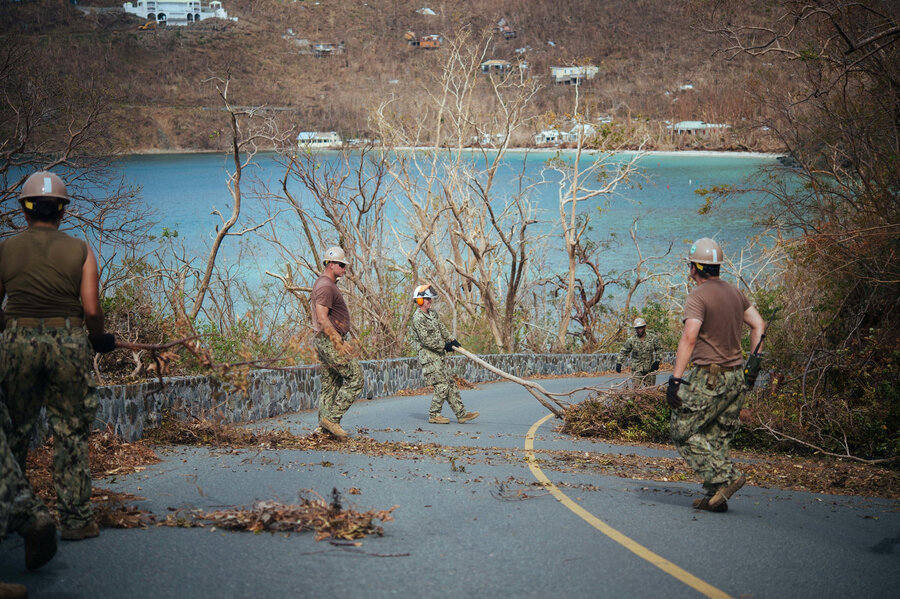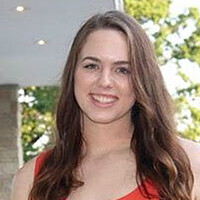How social media helped Caribbean islanders say: Don't forget us
Loading...
“US Virgin Islands. U.S. That’s us,” said MSNBC host Rachel Maddow in a segment devoted to the devastation hurricane Irma wrought across the United States Virgin Islands. Ms. Maddow’s report highlighted how hurricane Irma, a Category 5 storm, transformed the once green and leafy paradise in the southeastern Caribbean to a dull, brown mess.
But Maddow’s 15-minute report also proved how pleas for aid posted on social networks in the hurricane’s aftermath helped keep media attention on the smallest of the US Virgin Islands, even has Irma pummeled its way up Florida’s coast.
The message resounded over and over again: Don’t forget us.
Irma hit the islands on Sept. 6 with winds more than 185 miles per hour, peeling off metal roofs and overturning parked cars. Even sailboats sequestered into a harbor nicknamed “Hurricane Hole” for safekeeping suffered extensive damage.
In the following days, the hurricane-stranded islanders created a roll call on social media and relied on spotty cellphone connections to reach families and friends in the US. Facebook groups quickly formed with residents posting before and after photos and alarming reports of looters stealing ATMs and breaking into homes. The Stateside St. Johnians Alliance for Hurricane Irma Facebook page ballooned from 4,000 to 10,000 members within a matter of days.
As the Facebook, Twitter, and Instagram posts multiplied, reporters from The Washington Post, The Boston Globe,The New York Times, and even People magazine joined the chorus looking to interview eyewitnesses to the storm. Each time a new article was posted on one of the Facebook groups, a collective cheer went up online.
“There’s a definite recursive loop between social media and mass media,” says Cliff Lampe, an associate professor of information at the University of Michigan in Ann Arbor. “Reporters will track hashtags and different social media channels and that will shape the different types of events they report on.”
There are three uses of social media during a natural disaster, says Professor Lampe: coordinating the efforts of first responders, communicating between those affected and their broader network, and supporting recovery efforts. The introduction of social media to the hurricane relief effort has allowed for the creation of communities of support.
Social media helped to keep attention on the recovery efforts. But without traditional media to check and double-check all facts and place events in context, social media threatened to spread misinformation and magnify alarms.
“I’m pleased to say we did not have mass looting. We did have folks go into a couple of businesses, took out three ATMs, and breached them,” US Virgin Islands governor Kenneth Mapp told NPR’s All Things Considered. “We got National Guard units and got police officers.”
Despite fears voiced across social media that the US government would soon focus hurricane recovery efforts solely on Florida and other mainland US states, the government response on the island has been consistent and sustained. President Trump is also expected to visit the islands soon, as he did Florida, once weather safety concerns are met.
In addition to the National Guard, representatives of the US Navy, US Army Corps of Engineers, Environmental Protection Agency, Coast Guard, Health and Human Services, and Department of Energy are on the ground assisting survivors.
“We are here to support the US Virgin Islands,” says Federal Emergency Management Agency (FEMA) spokesman Alberto Pillot. “We will be here as long as we are needed…. We are all working together as a family.”
That could be awhile.
The majority of St. Thomas and St. John remain without power, and it may stay that way for the next few months. Many homes were damaged or destroyed, and tourism, the island’s main source of revenue, has been brought to its knees. Monies intended to cover insurance claims were spent on other expenses long ago. Many residents have fled for the safety of the mainland.
Even as the recovery process continues, Category 4 hurricane Maria approaches the US Virgin Islands, threatening to disrupt the lives of the islanders with 160 m.p.h. winds.
“Right now we are working on an emergency relief plan for hurricane Maria,” says Mr. Pillot.
Until then social media groups remain focused on community organizing.
Even before the Navy or FEMA were on the islands, volunteers and local rescue organizations initiated the recovery process. Multiple posts on Facebook recounted neighbors helping neighbors clear roads and access satellite phones. St. John Rescue, an emergency rescue organization based on St. John, and Global DIRT used K-9 units and thermal imaging drones to help find survivors trapped in debris.
Others expressed encouragement and prayers from afar.
One of those was David Leo Morley, a resident of northern California who moved to St. John five days before hurricane Hugo hit in 1989. In a Facebook post, Mr. Morley shared a hopeful story about the way the island recovered from that Category 5 storm in just a few months.
“The island was completely devastated,” says Mr. Morley in an interview with Monitor. “It wasn’t quite as bad as Irma’s destruction looks today, but it was really, really, terrible. The speed at which the green, new growth covered the island again in beauty really amazed me.”
He joined local crews and did hard labor to rebuild a medical clinic and found himself embraced by the local community faster than he might have been otherwise.
“What looked initially like the end of the world, ended up becoming a new beginning for me,” says Morley.
Contributors Hannah Schlomann and Han Zhao contributed to this report.
Editor's note: an earlier version of this story misstated the date hurricane Irma reached landfall in the US Virgin Islands. It was Sept. 6, 2017.






